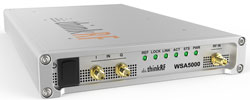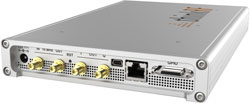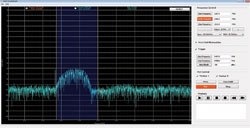
With capabilities that rival high-end lab equipment and at a fraction of the price, ThinkRF’s WSA5000 is a platform for all signal analysis applications. Modern wireless signals continue to become more complex while T&M budgets continue to shrink. This has created the need for high performance, low cost signal analysis. Typically, affordable spectrum analyzers have narrow bandwidths of around 10 MHz. This makes analyzing time-varying, wideband signals greater than 10 MHz in bandwidth impossible without a sweep over several frequency bands. Sweeps can yield inaccurate results and are not an adequate solution to measuring complex modern signals.
Normally, measuring sophisticated waveforms requires a wideband vector or real-time signal analyzer which can cost as much as $50,000 to $100,000. Furthermore, typical lab analyzers often weigh as much as 50 pounds and consume about 500 W of power, which makes them unsuitable for field applications. To meet this demand for portable, high performance, low cost, real-time spectrum analysis, ThinkRF has developed the WSA5000 – a powerful software-defined signal analysis platform.
Specifications
The WSA5000 was built with specifications that would allow it to be a truly universal solution to the majority of signal analysis applications. Many commercial waveforms are limited to a top frequency of 6 GHz but there are a number of applications that operate at higher frequencies. The WSA5000 was designed with a frequency range of 100 kHz to 20 GHz in order to facilitate those applications. Also, bandwidths of commercial wireless systems are steadily increasing to accommodate the demand for larger data rates. With this in mind, the device is built to have up to 100 MHz of instantaneous bandwidth. Some applications require the ability to quickly sweep across a number of frequencies. Scan speed for the WSA5000 – which determines how fast the device can jump from analyzing one set of frequencies to another set – is 200 GHz/s. A dynamic range between 70 to 80 dB is sufficient for many applications but in certain instances (like measurements for characterizing IP3) a dynamic range of around 100 dB is needed. The WSA5000 was designed with that in mind and so it has a 100 dB dynamic range.
Beyond technical requirements, many signal analysis applications have other considerations such as size, power consumption and price. The majority of devices currently on the market fall into to two size categories: very large or very small. The very large are usually used in lab environments and are not moved often whereas the very small are most commonly used for fieldwork. The WSA5000, which has the technical capabilities of lab equipment, is barely larger than a book and has less than half the power requirement of the average laptop – only 18 W. Lastly, price can be a prohibitive factor for many applications looking to reduce costs. This device starts at $3500.
Design
In order to achieve powerful specifications at such an aggressive price, ThinkRF needed to use new design techniques. The device was built using a combination of the three most common receiver architectures: super-heterodyne, homodyne (direct conversion) and direct digitization. While a super-heterodyne architecture is much better suited to real-time analysis, homodyne is better for applications that require a wide instantaneous bandwidth. The WSA5000’s architecture consists of a super-heterodyne front end with a back end that utilizes an I/Q mixer similar to that in a direct-conversion architecture. By building a device that allows the user to switch between these architectures, ThinkRF created a platform that meets the needs of most signal analysis applications.

Figure 1 ThinkRF's WSA5000 Back Panel with I,Q outputs and inputs, Gigabit Ethernet, GPIO and USB console.
Depending on the frequency of the signals being analyzed, one of three receiver signal processing paths is selected. Signals in the frequency range 100 kHz to 50 MHz are directly digitized, while all other signals are translated to the frequencies of the first IF block via one of the other two signal processing paths. The IF block consists of a bank of multiple SAW filters and any one SAW filter in this bank is selected depending on the frequency of the input signal. The output of the SAW filter feeds the I/Q mixer. Depending on the mode of operation, i.e., super-heterodyne or homodyne, either one or both outputs are utilized to process either 50 or 100 MHz instantaneously.
Open Platform
Beyond creating a powerful, low cost device, ThinkRF wanted to design a platform that would be open and customizable. This was accomplished through a combination of hardware and software. The hardware was designed so it could not only be used as a stand-alone device but also as a powerful RF front end that can be attached to an external digitizer. As a front end, the WSA5000 is capable of reaching 400 MHz of instantaneous bandwidth. Furthermore, the device has a high-speed Gigabit Ethernet port to allow for large-scale deployments that can be remotely monitored (see Figure 1).

Figure 2 Spectrum Analyzer Application featuring playback and trigger mode.
The application development environment for the WSA5000 was built in the Python language. Python is easy to use and develop for, has a rich environment of diverse libraries, is used by the scientific community and is free. The framework ThinkRF developed, called pyRF, and the spectrum analyzer application are freely available and under a flexible open-source BSD license. This means users cancustomize and/or commercialize the spectrum analyzer application for their own purposes (see Figure 2).
All Applications
The WSA5000 is a device that solves the problem of high performance, low cost signal analysis and does so in a form factor that is about the size of a paperback. It was built with specifications that fill the needs of most applications and can be effectively deployed in a variety of environments, such as in the lab, at a production facility or in the field. This combination of high-end specifications, small form factor and low price makes the WSA5000 the only solution suitable for most signal analysis applications.
ThinkRF,
Ottawa, Canada
(613) 369-5104,
sales@thinkrf.com
www.thinkrf.com
